#Western roe deer
Text
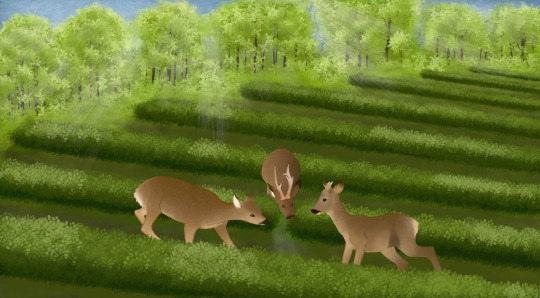
Deercember Day Two: European Roe Deer | Tea Party
The European roe deer (Capreolus capreolus), also known as the Western roe or simply roe, is widespread in Europe, ranging from Scotland to the Caucasus, the Mediterranean to Scandinavia, and as far East as Iran. Cultivated tea plantations (Camellia sinensis) are considered a deer-resistant plant, though their tender shoots from which more delicate green teas are harvested may be particularly alluring to the roe, who typically favour new growth, particularly on days after heavy rain. Roe deer are most closely related to water deer, and surprisingly, the species in this subfamily (Capreolini) are most closely related to moose and reindeer. More information here.
References: Deer, Tea.
#started with the background this time and I think it made a massive difference#though I also ran out of juice doing the deer themselves#doubt I'll keep up with backgrounds as far as I go‚ but this particular image came to me and needed a background to be expressed properly#Deercember#realHum#Art#Drawing#deer#deer art#European roe deer#Western roe deer#roe deer#Capreolus capreolus
7 notes
·
View notes
Text

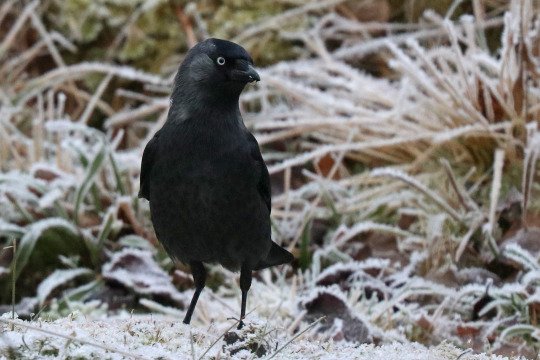
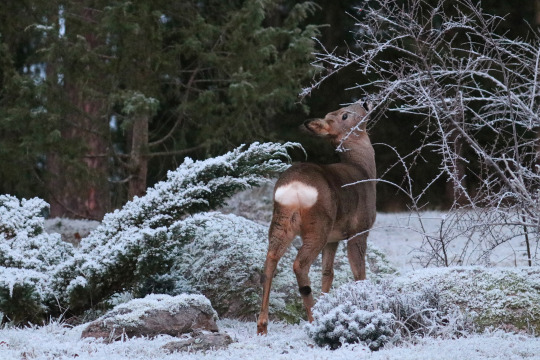
Friends in the garden. Eurasian red squirrel/ekorre, Western jackdaw/kaja and Roe deer/rådjur. Värmland, Sweden (December 26, 2020).
489 notes
·
View notes
Text
remember that wild Dragon Age theme park ride (Dragon Age: Flight of the Wardens), originally located in Dubai until it randomly turned up years later (now also oddly-rebranded as "[Not Dragon Age We Swears It]: The Guardian") in, of all places, Skegness England? well, I had to satisfy my curiosity and obsession with obscure pieces of Dragon Age media & archival thereof. and so - actually quite some time ago now - I finally got around to going on a pilgrimage there (which was this whole, like.. heinous harrowing in and of itself, that I will not go into), and I rode it

and to my surprise the original Dragon Age in-ride movie is still part of the ride experience! - complete with references to darkspawn, a Pride demon, dragons, green "rifts", Discount Anders (a Grey Warden[?] mage called 'Eldron'), Discount Yavanna (a Witch of the Wilds called 'Alexia') and Dragon Age: Inquisition soundtrack music. there is also now a new pre-ride movie which replaces the old Dragon Age pre-ride movie as part of the ride's rebranding, and i simply ?¿?

there are also still quite a lot of identifiable Dragon Age props in the fantasy-themed queue-area of the ride (so these must have been part of the whole purchase between parks), including multiple iconic Inquisitor helmets, Grey Warden shields, a Dragon Age dragon (now with DA-dragon identifiable horns.. sawn off??), and several Dragon Age banners, including the Inquisition hairy eyeball, the templar symbol and the Circle symbol. here's some pictures.
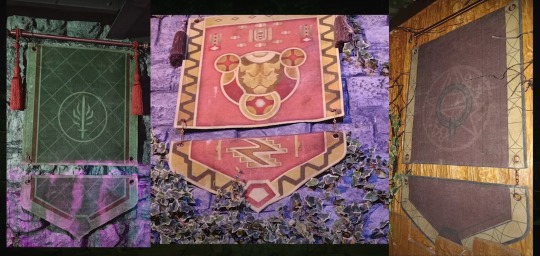
[^this image is taken from the video linked below]
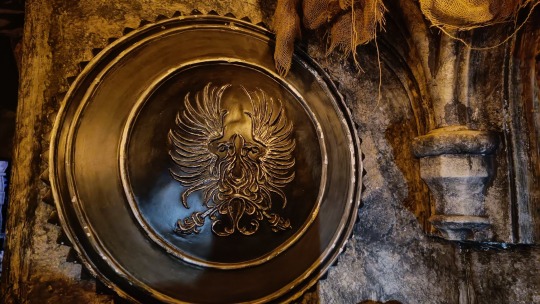
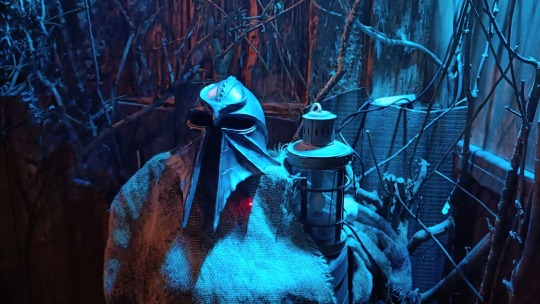
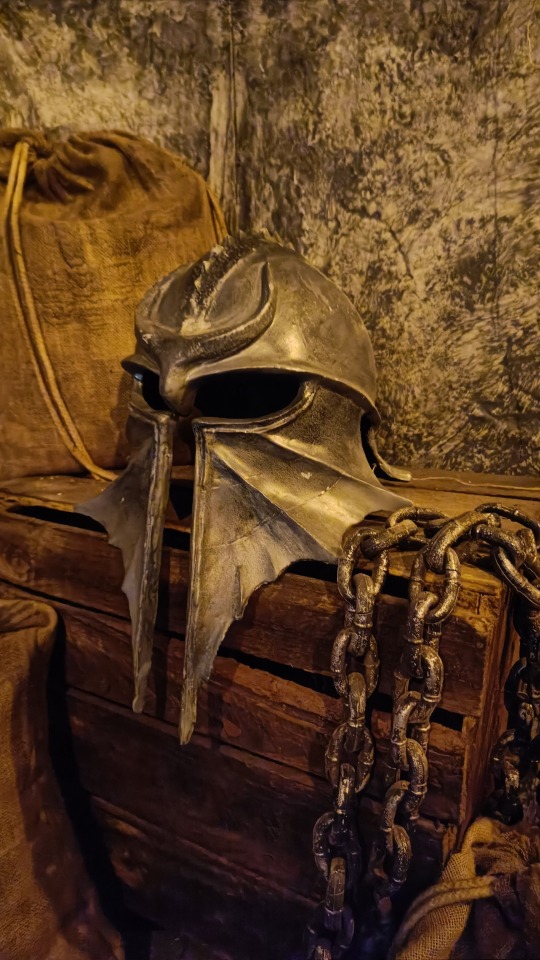

I also captured the new pre-ride movie, and you can see it along with the Dragon Age in-ride movie here ⬇️. and so now, with this epilogue to the.. most odyssey of all time, more than two years after the first message about the ride was ever sent to Ghil Dirthalen, this adventure in obscurity and the strange fever-dream meta story of the Dragon Age: Flight of the Wardens era in Dragon Age history is finally complete.
youtube
Ghil Dirthalen: The Guardian??? {Overview. - Spoilers All}
[video source & link: Ghil Dirthalen, posted here w/ permission]
some further notes, thoughts and commentary under the cut -
there's a few seconds missing from this capture of the in-ride movie. for the sake of the curious and completion: in them, you're still in the fort and you see lots of 'Wardens' walking and milling around.
a camera in the ride takes two photos of the riders during the ride, which are displayed on a screen on the way out. you can choose to buy these from the Fantasy Island merchandise store. you know those photos of people on log flume rides? it's like those, only of the four riders in a row in the seats. the photos have Fantasy Island branding on them and fire along the bottom, then in two corners there's a bit of a dragon's head and that's about it. the ride photo is the only Guardian-specific merch available at the park.
some of the queue area props appear to be from random other places. like there was a barrel which had something like "1850 distillery" written on it, which is obviously temporally/thematically and universe-ly out of place (not that that's at all unreasonable given the rest of the rideworld lore, there's totally a way it could have gotten there easily hh, see below), and I guess it's a spare or leftover prop from a Western-themed ride or something? others were generic sword'n'sorcery fantasy props (some of these are from the ride's previous life in Dubai though). there are also some pretty random props, like a dead stuffed roe deer's head on the wall and a.. comically large spoon.
there's music playing in the queue area, but it's not DA music, it's generic ye olde fantasy world music.
some folks there mistakenly thought that the long themed lead-up (it was pretty darn long) queue area with the props was the entrance to or start of something completely different, like a haunted house or maze type thing, or was the ride 'experience' in and of itself.
the ride attendant gives you the option of watching the new pre-ride movie or not. I guess they get sick of putting it on and listening to it 9000 times a day (valid), and also cutting it out reduces queue times as it's about five minutes long. it's screened in a little enclosed room at the end of the queue area. you go in and sit down, they show it to you, then you go through another door to the chair machine.
the in-ride movie is blurry and poor quality. I heard someone else who rode it say that it was so blurry that they had no idea what was going on hhh
Now about the new pre-ride movie. in the linked video, the start of the new pre-ride movie isn't included in full at normal speed as it seemed to be a compilation of whatever random fantasy-themed stock footage the video creator could find, stitched together. but again for the curious and the sake of completion: it starts out panning randomly around SPACE, like at the solar system and of planets and at the Milky Way. for a sec I wondered if it was made up of random old Mass Effect assets. then it shows dragons (FROM SPACE) invading an Earth-like planet where I suppose the Ferelden-y kindgom (formerly called "Noathen", now called "Elvia" or something) setting in the rideworld is now supposed to be set. these invading dragons invade either from space or.. another dimension?? or maybe from the future or both?? [see below], entering through a big green rift. (and they still have the green coloring for the rifts and call it/them "rifts" like in DA, which was honestly so funny to me for some reason). the whole panning in from space start to the movie reminded me a lot of the Easter eggs in the DA and ME games that, while they're just Easter eggs for fun and I don't subscribe to this theory myself (as DA is its own great, self-contained thing), could light-heartedly imply that the planet with Thedas on it is a planet in the MEverse (like the krogan head in the Winter Palace in DAI or the ogre in that ME dlc).
in the pre-ride movie, the kingdom of "Elvia" might have actually been called "Albion", which is the earliest-known name for the island of Britain. (it was hard to make out exactly what the king was saying there) the new pre-ride movie seems like it was made in England and ofc thats a common fantasy setting, so I could see it, especially since the king character's name was something like Aethylswyth, which sounded very "Old English". for me personally, if it was "Albion", it adds fuel to the fire of Caitie's cracktheory/"trying to make this fit"-headcanon for the ride story/lore (see Caitie's original video on the ride's previous life for this), that it's set somewhere obscure and backwatery in Ferelden, which is kinda England- or Britain-inspired. (dont take these thoughts or other thoughts in this post about the lore/canon etc too srsly pls hh, it's just crack for fun and I know tis just an off-brand themepark ride)
on the whole the new pre-ride movie is pretty random. there's a giant in it, but it doesn't look like a DAI giant. (is it his big spoon??) it shows a fortress in part of it which looks a bit like Skyhold if you squint, with the long bridge approaching it as the entrance. at one point one of the dragons that pops up is a dragon designed more in the style of a dragon as they are sometimes depicted in, for example, Chinese mythology and folklore. the "communication device" the king described had me rolling, it's exactly like a Dragon Age Skype Crystal or a working set of eluvians from Thedas.. I wondered if the video creator was inspired some by DAI promo images and took cues from the Inquisitor's green hand/the Anchor, since the king has a green glowing thing on (or in?) his chest. and when the king started listing the elements humans are made of, I was reminded of Fullmetal Alchemist.
also, "through a time rift".. I mean technically Dorian's involvement in DAI DOES show green space-time magic right? Where is this other dimension? ofc I know it's not literally Dragon Age, but it's funny to think about and to try and make it "fit" skhskdhfjhe. is it the Fade? the Void? from somewhere in-between like Tevinter Nights implies exists? or is it the dimension which has Thedas's mundane world itself in it - like maybe the dragons are invading this poor guy's kingdom dimension from Thedas? if so what tf is going on in Thedas?? did Solas' explosion at the Conclave ripple through spacetime and rip holes in the fabrics of other worlds as well - like is Solas out here accidentally causing interdimensional Space Dragon invasions? like, theoretically.. the new pre-ride move does reference the in-ride movie, and in turn the in-ride movie is still Dragon Age (!), so technically the new pre-ride movie IS.. kind of.. weirdly.. canon.
((the pre-ride movie references an "outerworld", implying that even in THAT dimension there's an outer world and an inner world, definitely more than one at least. and back on the dimensions thing, I'm not clear - are the dragons coming from Thedas dimension? or are they coming to Thedas dimension? "they came through the rift, human in form but with powers, the ability to fly [that's Eldron] and the ability to transform into dragon-like creatures [that's Alexia]" implies that the dimension on the other side of the rift - if the helpers came through the same rift as the invading dragons - is Thedas, because that's Eldron and Alexia from the Dragon Age in-ride movie being referred to, and Noathen where they're from is in Thedas somewhere. so some Thedosians have travelled to another world to save it?? Dragons are escaping out of Thedas? but.. from space? but also - the narration is telling us that Eldron and Alexia and the other Guardians brought with them from where they came from, as a gift, incredible advanced technology that the people of Elvia have never seen before. he then gives the example of "this communication device" which could be read meta-ly as meaning the television screen, and of plans to build a machine made of metal and advanced technology (meaning the ride machine you go sit on, which is a themepark machine irl obviously and in the 'world' of the ride, some kind of flying machine). so like.. are Eldron and Alexia from Future Thedas (think Avatar Aang/Korra, when by Korra's time there's like lots more machinery and a more modern feel), a Thedas which has advanced complex machines like idk, AEROPLANES? is that what they mean by "time-rift"? because they specifically did say "time". is that to try and explain the modern machinery? does that mean the invading dragons also came from the future, not just from space or another dimension? the other option: Eldron and Alexia came from alternate universe Thedas, which has more modern technology in it. but Thedosians Time-Travelling From The Future And Also Space And Another Dimension is so funny to me so lets go with that. my headcanon is that on the way to Elvia they also timetravelled through a Westernthemed time period and thats why theres a recent-modern period whisky barrel)).
in the ride's previous life, the explanatory hook was that Eldron made you a special harness or saddle thing with which to ride a dragon, which was what the ride machine was simulating. however now, the hook to explain the machine is that it's a gift of advanced technology powered by carbon, hydrogen, organic matter (Big Oil lmao?) etc. (I enjoyed that this explanatory hook got wackier between eras of the ride's life, much like the whole meta story of this piece of media itself. it was already weird because riding dragons isn't really part of DA. though I don't understand meta-ly speaking this convoluted explanation for the machine. dragon-riding isn't an identifiable or key part of the Dragon Age franchise, so they could have kept the idea that you're sitting on a dragon's back and flying around on that in instead of having this wacky explanation about a flying machine gifted from magical strangers from Back To The Future and it would have been fine. I love it though bc its so absurd)
And Tiny Dragon Alexia from the original ride experience is kinda referenced (unintentionally?) when the king introduces the dragon "Guardian" "Mia", as when she comes on-screen her size or scaling looks small/kinda off, so maybe Tiny Dragon lives on. so now we have Tiny Dragon Alexia, Tiny Dragon Mia, and Tiny Dragon queue prop. it's a Tiny Dragon Conference.
and like I just have so many questions. in her original video on the ride, Ghil Dirthalen wondered at length where in Ferelden/Thedas Noathen could be. where is Elvia? why does the pov of the pre-ride movie proceed downstairs into the room where the king is - like why does the king have his throne in a basement? is he in an underground bunker for safety because of the Space Dragon invasion? why does he say we "climbed" up when we have just gone down into his dungeon? why is the tiny dragon introduced as "Mia" when the tiny dragon witch lady in the in-ride movie is called "Alexia"? does the king's green glowing chest thing work like the Anchor - does he have a chest Anchor.. a Chanchor? where did they get Discount Gandalf from the queue area and why is he exactly like the Ghil Dirthalen Stock Theatre Wizards in her original video? why did they change the kingdom's name from "Noathen" to "Elvia" in the pre-ride movie when "Noathen" was already non-existent in Dragon Age lore? why did they scrub Dragon Age from or avoid Dragon Age in the pre-ride movie but leave the whole Dragon Age in-ride movie intact? are the "Guardians" Discount Grey Wardens? is the king's whole schpeel secretly an evil plot so he that can use our bodies for like necromancy-alchemy? why does the ride run on your flesh and are we about to be sacrificed in a blood magic ritual? do we end up like the husks in Mass Effect after our organic forms are broken down into compounds to fuel the King of Elvia's flying anti-dragon defense tank? is the actor of the king a park staffer who is into larping, or someone's fun nerd uncle who likes DnD? does Caitie not in fact agree that I am very handsome and smart, indeed the World's Most Interesting Guy? 😤 why go to the trouble of sawing off the dragon's DA-dragon horns when the in-ride movie is still Dragon Age?? why are the dragons invading from space anyway like what do they want??? how can I obtain the king actor guy's autograph? where are EA's lawyers? and why is there a giant spoon?
#dragon age#Not Dragon Age We Swears It#bioware#solas#video games#lul#long post#longpost#gpoy#mj and the world#saveserault#mass effect#(shoutout to the DA Archivists)#thanku to ghil for her vids and for permission to post this video here#this whole episode in my life and in the DA fandom feels like a strange shared fever dream. was that real? am i? is Skegness? is DA4? r WE?#lmaoo#skegness the swampy ass crack of england#Fantasy Island - where dreams go to die (but fever dreams live on)#(cant believe one of the pretend Wardens from Ghil Dirthalen's Eldron's fake Warden cult was literally there irl at Fantasy Island. im ded)#and if u are reading this thinking wat the heck fel r u ok its just a rebranded themepark ride like calm down its not That Deep#i grasp ur collar and raise you that#in the time between dai and DA:D i have fully lost my mind#what dragon age does to a guy#while we wait for dragon age 4 this is the plot of dragon age 4#on my knees constructing elaborate headcanons about and trying to make sense of a Not dragon age theme park ride#surrealism.txt
410 notes
·
View notes
Text
asking for definitely no reason absolutely no drawing in progress why do you ask? details of the types of deer below the poll
Blacktail- known for having large ears. common in western america
Whitetail- known for (gasp) having white tails. common in western america.
Elk- second largest species in deer family, although most people dont really think of them as deer. known for screaming. common in foresty america.
Reindeer- you know dasher and dancer and donner and vixen. found in mountainous northern america.
Coues- a specific type of whitetail. called "grey ghosts", they are known for being elusive. common in arizona mountains
Roe- small, reddish deer. has antlers that look actually pretty close to his. not native to america
Fallow- the deers with the spotted backs. usually kept deer, not necessarily wild in america. invasive to united states
Red- one of the largest deer species. they bark and roar. often dark red/brown with cream bellies. used as venison. have been found in texas, georgia, and pennsylvania
#alastor#hazbin hotel#hazbin#hartradio#hazbin fandom#its just.#their bodies are so different#and their antlers are all different shapes!#so yes im drawing him as a fucked up deer#but i have to commit to a type of deer#or risk making this ugly inaccurate deer amalgamation#hazbin alastor#alastor headcanons
91 notes
·
View notes
Text
The Regions of Kishetal
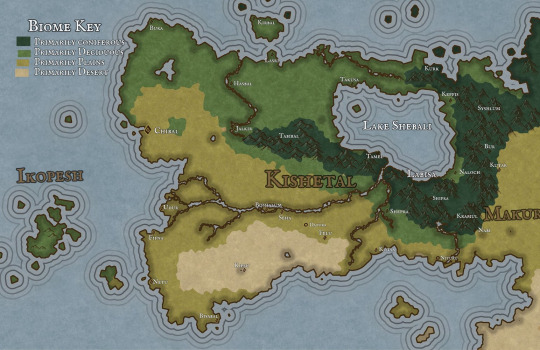
Pictured Above: An environmental map of the land of Kishetal

Pictured Above: A map of the 7 Kishic Regions
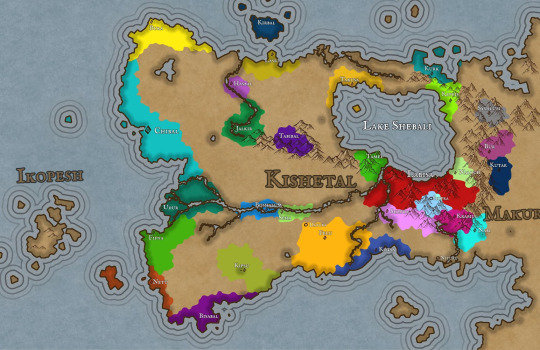
Pictured Above: A map of the Kishic City-States and their territories
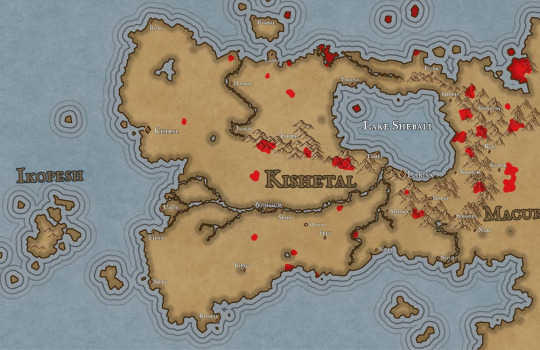
Pictured Above: A map of Significant Stable Forestfolk Populations
Here is a quick overview of the regions of Kishetal, the homeland of Narul and Ninma. And some good ol' maps. I'll be posting in the future about some of the creatures and forestfolk mentioned below!
As always send questions please!
Continues below the cut!
The Regions of Kishetal
1. The Red Cedar Mountains
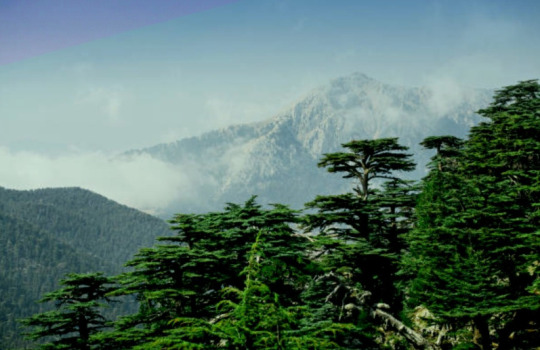
Pictured Above: The Red Cedar Mountains near Kepfis
The Red Cedar Mountains stretch from the Shabalic Sea in the north nearly to the Sea of Agitu in the south. The Red Cedar Mountains were formed in ancient times having already been present in the Age of Metal and Glass. However, the Red Cedar Mountains are not among the eleven “Chains of Sanctuary,” those mountain ranges around the planet in which humanity sheltered from the wrath of the gods during the Calamity. The predominant underlying stone of the RCM is limestone, with occasional but significant areas and deposits of serpentinite, basalt, and dolerite. The region experiences warm summers and cold winters, often with considerable snow and rainfall, particularly at higher elevations. The Mountains surround Lake Shebali, which acts as an inland sea and a source of food and transport for much of eastern Kishetal. At lower elevations, such as Labisa, the predominant vegetation is juniper and oak. Forests of black pine, cedar, and fir are dominant and common at higher elevations. The highest peaks are home to alpine meadows. Wild grapes, figs, and olives are all abundant in this region alongside their domesticated cousins.
Some fauna include wolves, jackals, wild goats, giant minks, wild bulls(aurochs), leopards, kishic lions, kishic tigers, caracals, roe deer, gazelle, wild boar, eagles, storks, horned rabbits, kishic brown bears, lynxes, and kishic ibex.
Very rarely found is the Kishic Elephant, actually a species of mammoth, these tiny pachyderms are about the same size as the average dairy cow. Only about 100 still survive in sheltered valleys to the north.
Examples of monstrous and magical Fauna including Flesh-eating deer, kiriki, dorasi, and the kutiri. While there are rumors of larger monsters such as dragons, these are mostly little more than legends and folklore. Though there is no telling what creatures could be hiding in the many caves and tunnels which dot the mountains.
There are numerous small forestfolk tribes which live in isolated areas.
(I will post more about that later)
2. The Felic Plain

Pictured Above: The Felic Plain north of Boshalum
The Felic Plains primarily consist of grassland with occasional patches of deciduous forest. The area is famed for its almond trees and its many wildflowers, including wild roses and hasir flowers. During the fall, great patches of the plains turn red with the blooming of hasir flowers.
The region experiences hot summers and mild but wet winters, which makes the region ideal for farming. As such, the Felic Plains act as the bread-basket of Kishetal. The region is split by the Aratshin River, which extends from Lake Shebali to the Green Sea. The plains are disrupted by an especially dense forested area known as the Garden. All attempts to settle the Garden have failed.
Fauna include, wolves, jackals, gazelles, wild bulls, kishic lions, deer, eagles, storks, horned rabbits, kishic brown bears, foxes, wild goats, polecats( which are popular pets), felic falcons, and hyenas.
The plains are home to several monstrous/magical species, including Flesh-eating deer, garudu, takmek, and the Unturu Serpent.
There are a handul of forestfolk tribes as well as a single hillfolk tribe in this region.
3. The Western Coast
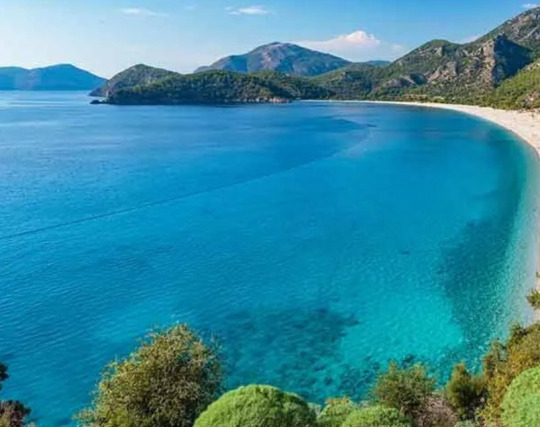
Pictured Above: The Western Coast near the city-state of Chibal
The Western Coast borders the Green Sea stretching from Bura in the north to Bisabal in the south. The ecoregion has a warm semi-tropical climate akin to a Mediterranean climate. Winter is the wettest season, and summer is the driest.
The Western coast consists primarily of three biomes. The deciduous forests in the north consist primarily of hornbeams, oaks, maples, cedar, and black pine. The central marshlands surrounding Udur have heavy concentrations of reeds, papyrus, poplar, and willow. The southern plains are similar to the Felic plain region though typically arider. Bay, olive, carob, and sweetgum are all common in this region. The Green Sea and its coast are home to many kinds of edible seaweed which form an essential part of the Chibalic and Buric diets.
Fauna include wild boars, foxes, jackals, wolves, badgers, wildcats, coastal brown bears, gazelles, deer, wild bulls, wild goats, and storks. Marine life includes dolphins, seals, whales, sea turtles, and many species of fish.
Monstrous fauna include bulari, sea-dragons, serpents, krinari, and ramitalek.
Aside from Ikopeshi's there are no surviving forestfolk tribes in this region.
4. The Northern Coast/Sheprian Forest

Pictured Above: The Sheprian Forest near Shepra
The Sheprian forest in the northern part of Kishetal is primarily composed of deciduous trees with occasional conifer patches at areas with higher elevations. Common trees include oak, chestnut, birch, hornbeam, black pine, cedar, and beech.
The climate is temperate with warm dry summers and cold wet winters. The north is typically thought of as the wildest region, with most city-states and settlements, including Shepra, clinging to the Corin river. Sheprian poetry is a unique variety of poetry, similar to the Japanese haiku, which originates from the forest festivals of the northern coast.
Fauna include wolves, jackals, gazelles, wild bulls, kishic lions, deer, eagles, storks, horned rabbits, kishic brown bears, foxes, wild goats, giant minks, horned rabbits, wild sheep, eagles, and kishic leopards.
Monstrous fauna include flesh-eating deer, garudu, kiriki, dorasi, and winged tigers.
This region contains the second highest concentration of forestfolk after the Red Cedar Mountains.
5. The Southern coast
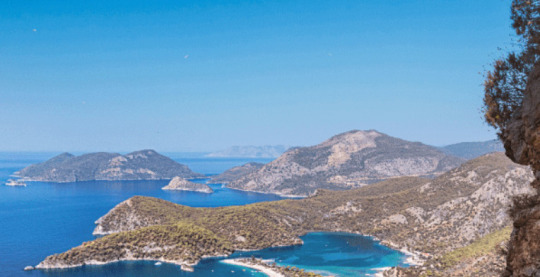
Placed Above: The Southern Coast near Bisabal
The Southern Coast consists of three regions; the southern deciduous forest, the scrubland, and the plains. The climate in the south is quite warm, with summers being hot and dry and winters mild in both temperature and rainfall. On rare occasions, the southern coast may experience heavy snowfall.
Major cities are sparse however, many villages dot the southern coast, many of these villages rely on piracy, preying primarily on Apunian and Jezaani ships traveling to and from the Western Coast.
Limestone plateaus and outcroppings are near the border of the southern coast, and the desert are said to be the remains of ancient buildings though this is not true.
Poplar, olive, bay, carob, almond, oaks, and umbrella pine are all common.
Fauna includes wolves, jackals, gazelles, wild bulls, kishic lions, deer, eagles, storks, horned rabbits, kishic brown bears, foxes, wild goats, polecats, felic falcons, kishic leopards, and hyenas.
The south is home to relatively few monstrous/magical species though it is home to the largest population of kiriki in Kishetal.
There are only two forestfolk populations in this region.
6. The Kipsian Desert
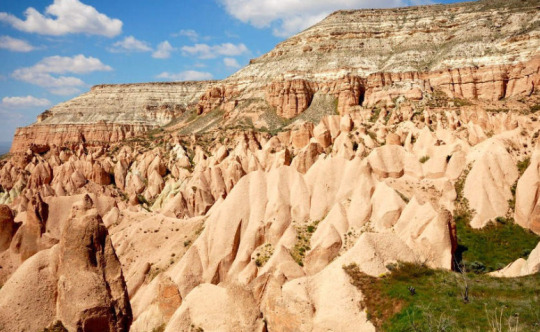
Pictured Above: The limestone formations of the Kipsian desert south east of Kipsu.
The Kipsian desert is the least populated region of Kishetal as the arid environment is not conducive to agriculture. Ruins of older civilizations suggest that the area may have once been more hospitable.
Plant life is sparse and largely limited to hardy shrubs and grasses. The region is famous for its carob and the candies and sweets produced from the carob by its inhabitants. Mesa, plateaus, pillars, and other stone structures are common; foreign visitors often visit the region seeking religious or spiritual enlightenment amongst the arches and columns. Many never leave.
Fauna include jackals, gazelles, kishic lions, deer, gazelle, wild asses, and hyenas. The Kipsian desert is also the only region in Kishetal in which the kishic ostrich and oryx survive.
Monstrous fauna include Flesh-eating deer, takmek, sikara, kiriki, and giant lions.
There are no forestfolk populations here.
7. The Makurian Steppe
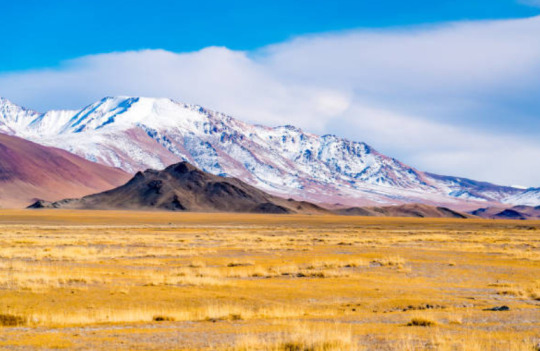
Pictured Above: The Makurian Steppe north of Shebal
The Makurian steppe is massive, spreading over most of western Masia. Only a tiny sliver of that vast extent falls in Kishetal. Trees are almost entirely absent. Vast expanses of grass-covered hills define the area. To the north of the steppe is the Shabalic forest, and to the south is the Jezaaic desert.
The heavy presence of sagebrush, sedges, and grasses and the relatively dry climate have led to a preference for a nomadic and pastoralist lifestyle. Makurian tribes regularly raid and intrude in the region, with their westward pushes typically being halted by the mountains.
Fauna include wild horses, wild asses, wild bulls, jackals, gazelle, deer, mountain sheep, macuri lions, and leopards.
Monstrous fauna include the tomob and the wulut.
There are only 3 native forestfolk populations in this region.
As always ask questions! Anything! And if y'all like this I might do this with some other regions.
@patternwelded-quill @flaneurarbiter @skyderman @blackblooms @roach-pizza @illarian-rambling @dezerex @theocticscribe @axl-ul, @persnickety-peahen @angie-j-kay
@surroundedbypearls I was looking through my intro post and I just realized I've been completely forgetting to put you in the taglist! Sorry about that!
#writeblr#writing#fantasy#worldbuilding#writer#fantasy writing#queer fantasy#fantasy world#testamentsofthegreensea#fantasy map#fantasy novel#fantasy worldbuilding#world building#narul#writblr
53 notes
·
View notes
Text
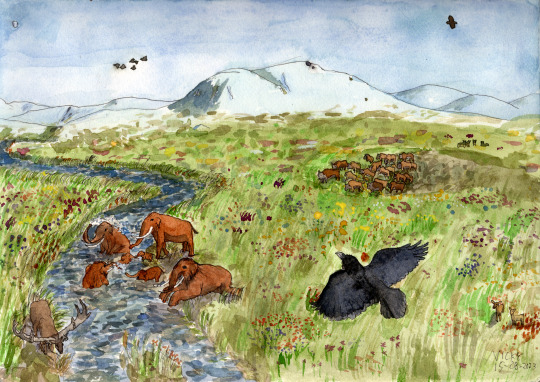
350000 years ago, just beyond the western edge of the icy Schwarzwald, spring has come to the mammoth steppe. A raven flies over a group of steppe mammoths enjoying a cold bath in the Oos river, while a Megaloceros grazes on some choice plants growing on the riverbanks. With the harsh ice age winter in retreat for a few months, a flock of greylag geese migrates north, a buzzard hunts, and a small pack of wolves observe a herd of steppe bison and some roe deer.
#steppe mammoth#raven#megaloceros#steppe bison#roe deer#wolf#buzzard#greylag goose#mammoth#proboscid#mammal#corvid#passerine#bird#deer#artiodactyl#bovid#canine#carnivore#quaternary#pleistocene#paleoart#my art#ice age#spring#mammoth steppe#schwarzwald#palaeoblr
141 notes
·
View notes
Text
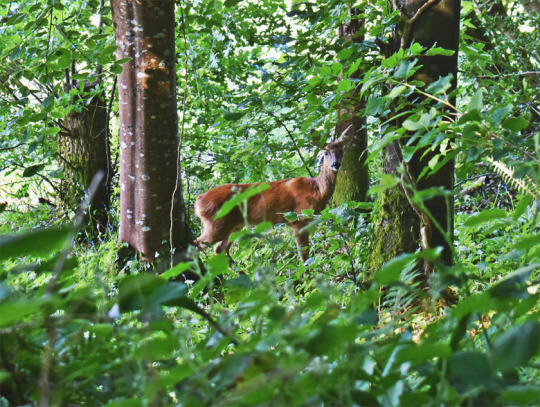
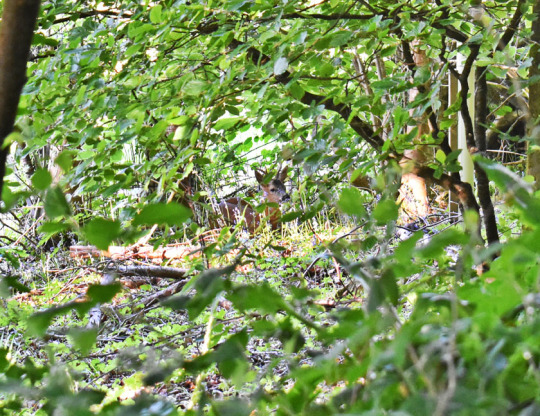
Western Roe Deer Capreolus capreolus
#cottagecore#dirtcore#goblincore#nature#nature photography#biology#ecology#wildlife#wildlife photography#macro photography#deer#roe deer#fauna#animals
85 notes
·
View notes
Text
The problem, [Frans Vera] explains, is that we have forgotten about the megafauna that would have been roaming our landscape before we arrived on the scene: large herbivorous mammals like the aurochs (the wild ox), tarpan (the original wild horse of Europe), wisent (the European bison), elk (known in North America as moose), European beaver and the omnivorous wild boar. All, according to fossil bone records, re-colonized the lowlands of Central and Western Europe along with red deer and roe deer about 2,000 years after the end of the last ice age – around 12,000 years ago. Trees, on the other hand – according to the pollen records – appear only between 9,000 and 1,500 years ago. So, oak, lime, ash, elm, field maple, beech and hornbeam – the key species of what is claimed to have been the primordial closed-canopy deciduous forest of Europe – arrived at least 3,000 years after the large herbivores. This is a very different picture to the one that has rooted in our mythology. It flies in the face of the received wisdom that closed-canopy forest is the natural habitat of these large animals. It also suggests – another heresy – that large herbivores played a part in, or at least did not prevent, the generation of trees in our landscape.
Isabella Tree, Wilding: The Return of Nature to a British Farm
99 notes
·
View notes
Text
JTTW Chapter 13 Thoughts
Chapter 13 for the @journeythroughjourneytothewest Reading Group! Very nature heavy this time!
On the title of the chapter while “detain” works well enough since they do hold up Tang Sanzang for a little bit, I prefer the other translations going with “entertains” for the J.F. Jenner translation and roughly translated “cares for” for the German one.
Tang Sanzang really enjoys making vows doesn’t he. I hope this won’t come back to bite him later.
Since they get mentioned multiple times this chapter and I already figured out that flowers in this story may not be arbitrarily chosen I looked into the Chinese flower language of chrysanthemums! These lovely flowers.

First up chrysanthemums are Autumn flowers, which tracks perfectly here given that it is late Autumn. Additionally they apparently are the flower of the ninth moon aka ninth month which is the month in which Tang Sanzang departed, so that works exceptionally well too! Also they symbolize longevity, which could tie into the story as well.
Oooh, the travel group is technically comprised of four people currently, which is deliberately mentioned! And it is the fourth night watch when they set off this time as well! Now if that isn’t blatant foreshadowing through the meaning of numbers.
I really love those little details with flower meanings and numerology.
When Tang Sanzang “was so frightened that his spirit left him” everyone who watched so much as a single anime probably had a very specific kind of image in their head for this.
I’d like to draw some attention to the depiction of those yaoguai in how they interact with each other and that they actually left the horse alone. It makes me see them as not really malicious as such, they kind of just treat humans how humans would treat animals and given that they are in part animal, well you can guess how that fits together.
Ah yes, they didn’t eat him because of his nature. And literal plot armour.
At this point I would also like to present the illustration in the German translation this chapter. Particularly focusing on Tang Sanzang, who is tied up like a little package! I don’t know it looks kind of funny to me context aside.
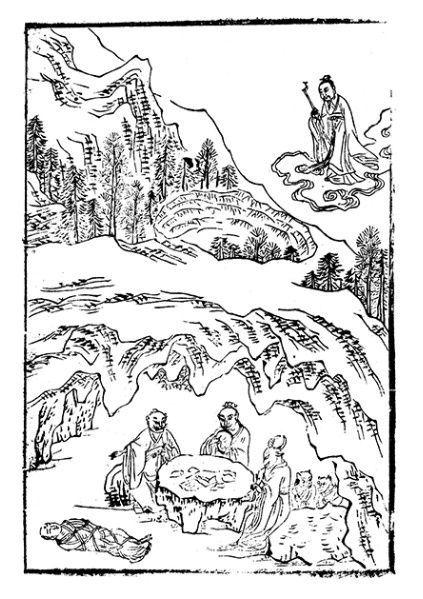

Though it’s also interesting because when you imagine someone tied up you tend to do so like in Westerns for example with the rope tied around the arms and chest in a cylindrical manner and not this net-like manner as depicted here.
Tang Sanzang could really just have told Boqin from the start that he doesn’t eat meat. Though to be fair he likely had a lot going through his head at the time.
Lastly with the deer mentioned I would like to show off this neat info graphic I found on different species of deer! Looking at it I noticed how all the deer in the translation are specifically European deer, so those are definitely not the actual kind of deer!
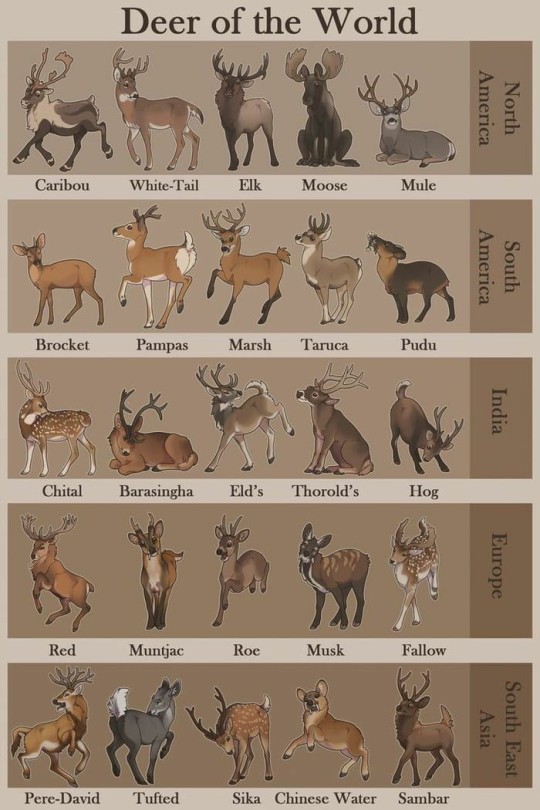
Subsequently I got curious and checked the Chinese original for some deer. First one is [獐] or Chinese Water Deer! That character is translated as Roe in Google translate, when Musk would at least provide a similar look with their teeth, so I’m happy that Anthony C. Yu chose Musk Deer here.
Then we have [麂], which are indeed Muntjac Deer as the Google translate told me! Turns out what isn’t clear in the info graphic is that there are Muntjac in Europe and Asia! So I find it a bit odd that Anthony C. Yu went with Fallow Deer instead. The J.F. Jenner translation goes with the same translation as Google translate gave me by the way.
The herd of deer later are Water Deer again. The dozen deer mentioned seem to just use the general character for deer, though feel free to correct me if the character [鹿] does mean a specific kind of deer after all.
Also if you are curious what kind of deer meat Boqin ate, it’s Water Deer.
#xiyouji#journey to the west#jttw#tang sanzang#jttw reading group#jttw book club#chrysanthemum#deer#chinese water deer#muntjac deer
25 notes
·
View notes
Text
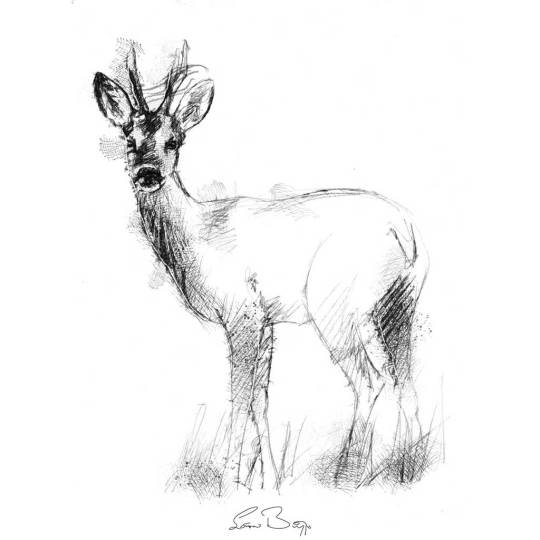
Roe doe deer sketch | Limited edition fine art print from an original drawing.
The roe deer, also known as the roe, western roe deer, or European roe deer, is a species of deer. The male of the species is sometimes referred to as a roebuck. The roe is a small deer, reddish and grey-brown, and well-adapted to cold environments.
My sketches start life as hand-drawn graphite images made on cartridge paper. I often work on these with charcoal, oil pastel or Caran d'Ache to create the look I'm after. The artwork is then scanned and finessed digitally ready for fine art printing. This process often referred to as Giclée printing uses the highest standard of printing methods to give gallery quality results that maintain all the details of the original sketch.
The graphite pencils I use are Faber-Castel, the oil pastels are Sennelier and the china-graph is Caran d’Ache. The inks are pigment based archive quality (100years+). The heavyweight specialist papers I use are of the best professional quality having a wonderful surface designed specifically for fine art drawings and illustrations.
Very limited editions with only ten per size printed.
All artwork is signed and includes a certificate of authenticity.
The A5 are 5.8" x 8.25" (14.8cm x 21cm)
The A4 are 8.25" x 11.7" (21cm x 29.8cm)
The A3 are 11.7" x 16.5" (29.8 cm x 42cm)
The A2 are 16.5" x 23.4" (42 cm x 59.4cm)
Frames not included in price.
Free shipping on artwork to UK destinations.
5 notes
·
View notes
Text
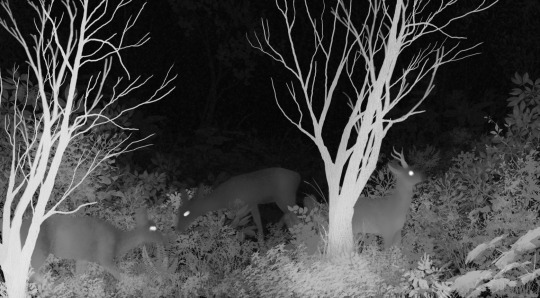
Deercember Day Seven: European Roe Deer | Fairy Festival
The European roe deer (Capreolus capreolus), also known as the Western roe or simply roe, is widespread in Europe, ranging from Scotland to the Caucasus, the Mediterranean to Scandinavia, and as far East as Iran. Roe deer populations—combining European and Siberian species—gradually become somewhat larger as one moves further to the East, peaking in Kazakhstan, then becoming smaller again towards the Pacific Ocean. In order to mitigate risk, roe deer remain within refuge habitats (such as forests) during the day. They are likelier to venture into more open habitats at night and during crepuscular periods when there is less ambient activity. Roe deer will generally not venture into a field that has or has had livestock in it. More information here.
References: Deer 1 and Background, Deer 2, Deer 3.
#week one complete!!!#had to reuse roe because I think there are only six species native to the range? and didn't want to use non-native species#interpreted “fairy” loosely because I'm drawing these in a realistic scope#so themed this off of fae‚ which trail cam night footage reminds me of#much happier with this one than the past two days!#Deercember#realHum#Art#Drawing#deer#deer art#European roe deer#Western roe deer#roe deer#Capreolus capreolus
5 notes
·
View notes
Photo
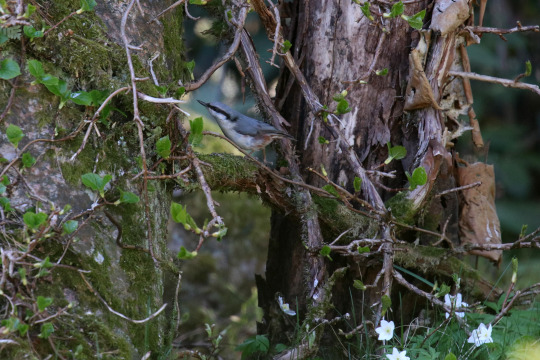



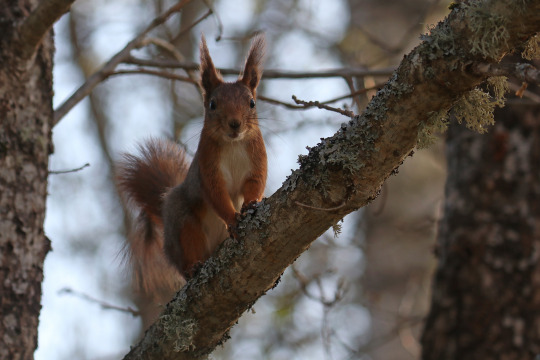
Sunday in the garden. Värmland, Sweden (May 8, 2022).
282 notes
·
View notes
Photo


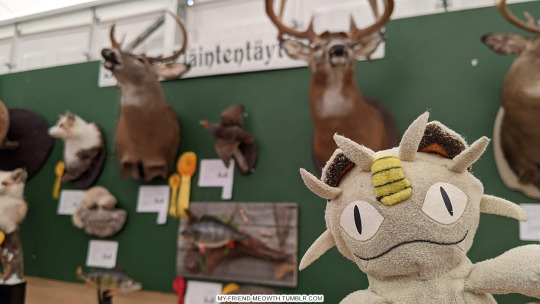


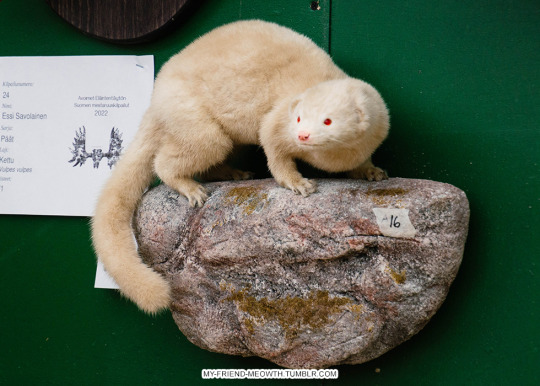

Meowth & mounted animals, red fox, bean goose, european perch, white-tailed deer, roe deer, western jackdaw, european pine marten, eurasian lynx
XXIV International Sportsmen’s Fair, Riihimäki, Finland
8 notes
·
View notes
Text
Eastern Roe Deer - Beautiful and Wild Siberian Roe Deer

If you've ever wanted to know all there is to know about eastern roe deer, then this guide is for you.
What is The Siberian Roe Deer?
The Siberian roe deer (Capreolus pygargus) is a species of deer that is native to the northern and central regions of Asia, including Siberia. It is one of the smallest species of true deer, with males (bucks) typically weighing around 60 to 75 kilograms (130 to 165 pounds) and females (does) being slightly smaller.
The Siberian roe deer has a reddish-brown coat in summer and a grayish-brown coat in winter, which helps it blend into its surroundings. It is known for its distinctive white rump patch, which is larger and more prominent in males. Siberian roe deer primarily feed on grasses, leaves, and buds, and they are known for their agility and jumping ability. They are an important game species and are also hunted for their meat and antlers.
What is Eastern Roe Deer Size?
The Eastern roe deer (Capreolus capreolus) is slightly larger than its Siberian counterpart. Male Eastern roe deer, known as bucks, typically weigh between 25 and 45 kilograms (55 to 99 pounds), while females, known as does, usually weigh between 15 and 35 kilograms (33 to 77 pounds). They have a compact body with a short neck and slender legs.
Geographic Range
The Eastern roe deer (Capreolus capreolus) is native to a wide geographic range that spans Europe and parts of Asia. In Europe, it can be found in various countries including the United Kingdom, Ireland, France, Germany, Poland, Russia, and many others. Its distribution extends from the western regions of Europe, such as Portugal and Spain, to the eastern parts, including Russia and the Caucasus region.
Eastern roe deer populations are also present in parts of Asia, including Turkey, Iran, and the western regions of the former Soviet Union. The specific range of the Eastern roe deer may vary within its overall distribution depending on local habitat suitability and historical factors.
Eastern Roe Deer Habitat

Eastern Roe Deer Habitat
The Eastern roe deer (Capreolus capreolus) inhabits a variety of habitats across its range. It is adaptable and can be found in diverse environments, including forests, woodlands, meadows, shrublands, and agricultural areas. Eastern roe deer prefer habitats with a mixture of open areas for grazing and cover for concealment and shelter. They are often associated with edge habitats, such as forest edges or clearings, where they can find a balance between food availability and protection.
In forests, Eastern roe deer can be found in both coniferous and deciduous forests, although they tend to prefer mixed forests with a variety of tree species. They utilize the understory for browsing on shrubs and grasses, while also taking advantage of fallen fruits and nuts. In more open areas, such as meadows and agricultural fields, they graze on grasses, herbs, and crops.
Water sources, such as rivers, streams, and ponds, are also important for Eastern roe deer as they provide drinking water and can serve as natural barriers or boundaries for their home ranges.
Overall, Eastern roe deer exhibit habitat flexibility and can adapt to various landscapes as long as they have access to suitable food sources and cover for shelter and protection.
Siberian roe deer Reproduction -Breeding
The Siberian roe deer (Capreolus pygargus) follows a seasonal breeding pattern, commonly referred to as rutting. The rutting season for Siberian roe deer typically occurs in late July to early August. During this time, male roe deer, known as bucks, engage in intense competition for access to females, known as does.
Bucks establish territories and mark them with scent markings and by thrashing vegetation with their antlers. They also produce vocalizations and engage in aggressive behaviors such as parallel walks and sparring with rival bucks. These displays and contests are aimed at asserting dominance and attracting receptive females.
Once a dominant buck has successfully secured a territory, he will attempt to mate with as many does as possible. Does enter estrus, or the period of sexual receptivity, for a short duration, typically lasting about 24 to 48 hours. During this time, the dominant buck will actively seek out and mate with receptive does.
After mating, a doe undergoes a gestation period of around 280 days, which is roughly nine months. This long gestation period includes a phenomenon called delayed implantation, where the fertilized egg does not immediately implant in the uterine wall. Instead, it remains dormant for several months before implanting and initiating active growth.
In late spring or early summer, the doe gives birth to one or two fawns, which are typically well-camouflaged and have spotted coats to aid in blending with their surroundings. The fawns are nursed by the mother and remain with her until they are weaned at around three to four months of age.
It's worth noting that the specific timing of breeding and the number of fawns can vary depending on environmental conditions and population dynamics.
How Long Does A Siberian Roe Deer Lifespan?
The lifespan of a Siberian roe deer (Capreolus pygargus) can vary depending on various factors such as habitat conditions, predation pressure, and availability of resources. In general, the average lifespan of a Siberian roe deer in the wild is around 10 to 15 years. However, some individuals have been known to live up to 20 years or more in favorable conditions.
Factors such as disease, predation, hunting, and competition for resources can impact the survival and longevity of Siberian roe deer. Additionally, environmental factors such as severe weather conditions and food scarcity can also influence their lifespan.
It's important to note that the lifespan of Siberian roe deer in captivity can be longer, with individuals reaching 15 to 20 years or more. In captivity, they are protected from predators and have consistent access to food and veterinary care, which can contribute to their extended lifespan.
Communication And Perception

Anti-predator Adaptations
Siberian roe deer (Capreolus pygargus) communicate through a variety of vocalizations, body postures, scent marking, and visual displays. Here are some key aspects of their communication and perception:
Vocalizations: Siberian roe deer produce a range of vocalizations to communicate with each other. These include barks, grunts, whistles, and various calls during the breeding season. These vocalizations are used to attract mates, establish dominance, warn of danger, and maintain contact with other individuals.
Scent marking: Both males and females use scent marking to communicate their presence and reproductive status. They have scent glands on their faces, hooves, and metatarsal glands, which they use to leave scent marks on trees, vegetation, and the ground. This helps in territorial marking and signaling information to other deer in the area.
Body postures and visual displays: During the breeding season, males exhibit aggressive behaviors and visual displays to establish dominance and attract females. This includes parallel walks, thrashing vegetation with antlers, and sparring with rival males. These displays communicate dominance and readiness to mate.
Visual and auditory perception: Siberian roe deer have well-developed senses of vision and hearing. Their large, forward-facing eyes provide a wide field of view and excellent depth perception, aiding in detecting predators and other deer. They also have a keen sense of hearing to detect sounds, including low-frequency vocalizations and the rustling of vegetation.
Olfactory perception: The sense of smell is crucial for communication and perception in roe deer. They have a highly developed olfactory system and use scent cues to identify individuals, determine reproductive status, mark territories, and detect potential threats.
Interspecies communication: Siberian roe deer also interact with other species in their habitat. They may respond to alarm calls from other animals, such as birds or squirrels, which can signal the presence of predators. They also interact with their predators, such as wolves and lynx, through defensive behaviors and alarm signals.
In summary, Siberian roe deer communicate through a combination of vocalizations, scent marking, body postures, and visual displays. Their well-developed sensory perception allows them to gather information about their environment, detect threats, establish social hierarchies, and communicate reproductive status within their species.
What Do Eastern Roe Deer Diet?
Eastern roe deer (Capreolus capreolus) are herbivores, and their diet primarily consists of plant materials. They are selective feeders and consume a variety of vegetation based on seasonal availability. Here are some key components of the Eastern roe deer's diet:
-
Grasses: Grasses form a significant part of the Eastern roe deer's diet. They feed on a variety of grass species, including both tall grasses and shorter, more nutritious grasses found in meadows and open areas.
-
Herbaceous plants: Eastern roe deer also consume a wide range of herbaceous plants, including leafy plants, herbs, and forbs. They feed on the leaves, stems, and flowers of these plants.
-
Shrubs and woody plants: Roe deer browse on the twigs and leaves of shrubs and small woody plants. They may consume various shrub species, including hawthorn, blackthorn, rose, and bramble.
-
Tree foliage: Eastern roe deer can feed on the foliage of certain tree species, especially in the winter when other food sources may be scarce. They may browse on the leaves and twigs of trees such as birch, willow, aspen, and oak.
-
Crops: In areas where agricultural fields are present, Eastern roe deer may feed on crops such as wheat, barley, oats, and maize. This can lead to conflicts with farmers, as they can cause damage to crops.
The specific composition of the Eastern roe deer's diet can vary depending on factors such as habitat, seasonal availability of food, and local plant species. They have a relatively diverse diet and can adapt to different food sources based on availability and nutritional content.
Anti-predator Adaptations
Eastern roe deer (Capreolus capreolus) have evolved several anti-predator adaptations to increase their chances of survival and avoid predation. Here are some notable adaptations:
-
Camouflage: Roe deer have a coat coloration that provides effective camouflage in their natural habitats. Their reddish-brown or grayish-brown fur blends with the surrounding vegetation, helping them remain concealed from predators.
-
Alertness and vigilance: Eastern roe deer have well-developed senses, including keen eyesight and acute hearing. They are constantly alert, scanning their surroundings for signs of predators. Their large, forward-facing eyes provide a wide field of view, enabling them to detect potential threats from different directions.
-
Speed and agility: When faced with immediate danger, roe deer rely on their remarkable speed and agility to evade predators. They can reach speeds of up to 40-50 kilometers per hour (25-30 miles per hour) in short bursts and maneuver quickly through dense vegetation or obstacles.
-
Escape strategies: Roe deer are adept at employing escape strategies to avoid predation. They often rely on their agility to zigzag or change direction rapidly, making it difficult for predators to pursue them. They can also utilize their smaller size to their advantage by slipping through narrow gaps or dense vegetation that larger predators may struggle to navigate.
-
Alarm signals: Eastern roe deer have a variety of vocalizations and alarm signals to alert nearby individuals of potential danger. When a roe deer detects a predator, it can emit a loud barking sound, signaling a warning to other deer in the area.
-
Group behavior: Roe deer sometimes form small social groups, especially during the winter months. Being in a group provides them with increased vigilance and the ability to detect predators more effectively. If a predator is spotted, individuals in the group may coordinate their actions to evade or confront the threat.
-
Scent marking and avoidance: Roe deer use scent marking to establish territories and communicate with other individuals. They also possess the ability to detect the scent markings of predators and adjust their behavior accordingly, avoiding areas where predator scent is strong.
These anti-predator adaptations collectively enhance the Eastern roe deer's chances of survival by improving their ability to detect, evade, and deter predators in their environment.
Ecosystem Roles
Eastern roe deer (Capreolus capreolus) play important ecosystem roles within their habitats. Here are some of their key roles:
-
Herbivory: As herbivores, roe deer contribute to shaping plant communities by consuming various vegetation. Their feeding behavior influences plant species composition, nutrient cycling, and growth patterns. They help control vegetation density and promote diversity by selectively browsing certain plants, which can impact the structure and composition of plant communities.
-
Seed Dispersal: Roe deer can act as seed dispersers by consuming fruits, seeds, and berries from various plant species. They may transport seeds over distances and deposit them in new locations through their feces. This aids in the dispersal and colonization of plant species, contributing to plant populations' regeneration and genetic diversity.
-
Grazing Patterns: The foraging behavior of roe deer, such as selective browsing, can shape the structure and distribution of plant communities. Their feeding preferences and patterns can affect the growth, survival, and competitive interactions among plant species. This can influence vegetation dynamics and the availability of resources for other herbivores and plant-eating species.
-
Prey for Predators: Eastern roe deer serve as prey for a variety of predators, including wolves, lynx, bears, and large raptors. They form an important component of the food web, providing a vital food source for these carnivores and helping maintain predator populations and their ecological interactions.
-
Indicator Species: The presence and behavior of roe deer can provide valuable information about the health and integrity of ecosystems. Changes in their population density, behavior, or distribution can indicate shifts in habitat quality, availability of resources, or impacts from human activities. Monitoring roe deer populations can help assess the overall well-being of the ecosystems they inhabit.
-
Trophic Interactions: Through their herbivory, roe deer can influence the abundance and availability of resources for other organisms within the ecosystem. They can indirectly impact other herbivores, such as by competing for food resources or modifying vegetation structures. These trophic interactions can have cascading effects on other species and ecosystem dynamics.
Conservation Status
The conservation status of the Eastern roe deer (Capreolus capreolus) varies depending on the specific populations and regions. Overall, the species is not globally threatened and is categorized as of "Least Concern" by the International Union for Conservation of Nature (IUCN). However, it's important to note that regional populations may face localized threats and conservation concerns.
The Eastern roe deer has a relatively wide distribution across Europe and parts of Asia. It is adaptable to various habitats, including forests, meadows, and agricultural areas, which has contributed to its population stability and resilience.
Conservation efforts for the Eastern roe deer primarily focus on habitat conservation, wildlife management, and addressing specific threats to local populations. These threats can include habitat loss and fragmentation due to land development, agricultural expansion, and urbanization. Additionally, illegal hunting and poaching can pose challenges in certain areas.
Conservation measures typically involve establishing protected areas and wildlife management practices that promote sustainable hunting, habitat restoration, and population monitoring. Collaboration between governmental agencies, conservation organizations, and local communities is crucial for the successful conservation of Eastern roe deer populations.
How Fast Can An Eastern Roe Deer Run?
Eastern roe deer (Capreolus capreolus) are known for their agility and speed when it comes to evading predators or escaping potential threats. They are capable of reaching impressive speeds for short distances. On average, an Eastern roe deer can run at a speed of around 40 to 50 kilometers per hour (25 to 30 miles per hour).
Their running speed allows them to quickly cover ground and navigate through various terrains, including dense vegetation, forests, and open fields. They can make sudden changes in direction and use their agility to evade predators or potential dangers. However, their sustained speed is typically lower, and they rely more on their ability to maneuver and take advantage of their environment to escape threats effectively.
Population
The eastern roe deer population is estimated at between 15-25 million.
- Referans: Mitochondrial DNA variation in eastern roe deer
- Siberian roe deer
Persian Fallow Deer Facts and Information ( What You Need to Know)
What is the difference between a deer and a roe deer
Roe deer have dark brown or black-brown coats in the summer and are lighter in color in the winter. They have white bellies and white spots on their necks and rumps.
Deer is a term used for many different species of ungulate mammals from the family of Cervidae, which includes animals such as African wild ass, fallow deer, caribou, moose, reindeer, and others.
Are roe deer protected in the UK?
The eastern roe deer have been protected in the UK since 1991. In addition to that, it is also protected in Europe, Russia, and Scandinavia.
Read the full article
0 notes
Text
The Regions of Kishetal

Pictured Above: An environmental map of the land of Kishetal

Pictured Above: A map of the 7 Kishic Regions

Pictured Above: A map of the Kishic City-States and their territories
Continues below the cut!
The Regions of Kishetal
1. The Red Cedar Mountains

Pictured Above: The Red Cedar Mountains near Kepfis
The Red Cedar Mountains stretch from the Shabalic Sea in the north nearly to the Sea of Agitu in the south. The Red Cedar Mountains were formed in ancient times having already been present in the Age of Metal and Glass. However, the Red Cedar Mountains are not among the eleven “Chains of Sanctuary,” those mountain ranges around the planet in which humanity sheltered from the wrath of the gods during the Calamity.
The predominant underlying stone of the RCM is limestone, with occasional but significant areas and deposits of serpentinite, basalt, and dolerite.
The region experiences warm summers and cold winters, often with considerable snow and rainfall, particularly at higher elevations. The Mountains surround Lake Shebali, which acts as an inland sea and a source of food and transport for much of eastern Kishetal.
At lower elevations, such as Labisa, the predominant vegetation is juniper and oak. Forests of black pine, cedar, and fir are dominant and common at higher elevations. The highest peaks are home to alpine meadows. Wild grapes, figs, and olives are all abundant in this region alongside their domesticated cousins.
Some fauna include wolves, jackals, wild goats, giant minks, wild bulls(aurochs), leopards, kishic lions, kishic tigers, caracals, roe deer, gazelle, wild boar, eagles, storks, horned rabbits, kishic brown bears, lynxes, and kishic ibex.
Very rarely found is the Kishic Elephant, actually a species of mammoth, these tiny pachyderms are about the same size as the average dairy cow. Only about 100 still survive in sheltered valleys to the north.
Examples of monstrous and magical Fauna including Flesh-eating deer, kiriki, dorasi, and the kutiri. While there are rumors of larger monsters such as dragons, these are mostly little more than legends and folklore. Though there is no telling what creatures could be hiding in the many caves and tunnels which dot the mountains.
There are numerous small forestfolk tribes which live in isolated areas.
(I will post more about that later)
2. The Felic Plain

Pictured Above: The Felic Plain north of Boshalum
The Felic Plains primarily consist of grassland with occasional patches of deciduous forest. The area is famed for its almond trees and its many wildflowers, including wild roses and hasir flowers. During the fall, great patches of the plains turn red with the blooming of hasir flowers.
The region experiences hot summers and mild but wet winters, which makes the region ideal for farming. As such, the Felic Plains act as the bread-basket of Kishetal. The region is split by the Aratshin River, which extends from Lake Shebali to the Green Sea. The plains are disrupted by an especially dense forested area known as the Garden. All attempts to settle the Garden have failed.
Fauna include, wolves, jackals, gazelles, wild bulls, kishic lions, deer, eagles, storks, horned rabbits, kishic brown bears, foxes, wild goats, polecats( which are popular pets), felic falcons, and hyenas.
The plains are home to several monstrous/magical species, including Flesh-eating deer, garudu, takmek, and the Unturu Serpent.
There are a handul of forestfolk tribes as well as a single hillfolk tribe in this region.
3. The Western Coast
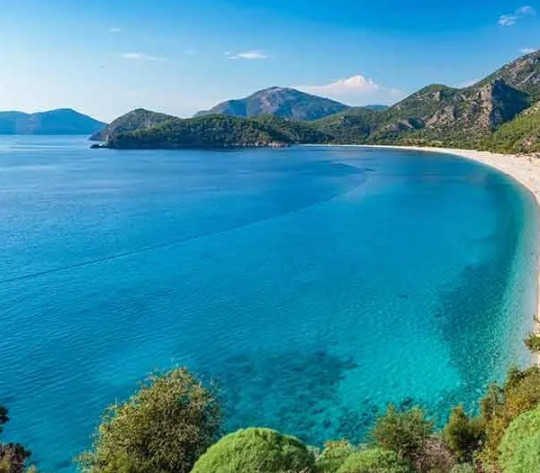
Pictured Above: The Western Coast near the city-state of Chibal
The Western Coast borders the Green Sea stretching from Bura in the north to Bisabal in the south. The ecoregion has a warm semi-tropical climate akin to a Mediterranean climate. Winter is the wettest season, and summer is the driest.
The Western coast consists primarily of three biomes. The deciduous forests in the north consist primarily of hornbeams, oaks, maples, cedar, and black pine. The central marshlands surrounding Udur have heavy concentrations of reeds, papyrus, poplar, and willow. The southern plains are similar to the Felic plain region though typically arider. Bay, olive, carob, and sweetgum are all common in this region. The Green Sea and its coast are home to many kinds of edible seaweed which form an essential part of the Chibalic and Buric diets.
Fauna include wild boars, foxes, jackals, wolves, badgers, wildcats, coastal brown bears, gazelles, deer, wild bulls, wild goats, and storks. Marine life includes dolphins, seals, whales, sea turtles, and many species of fish.
Monstrous fauna include bulari, sea-dragons, serpents, krinari, and ramitalek.
Aside from Ikopeshi's there are no surviving forestfolk tribes in this region.
4. The Northern Coast/Sheprian Forest

Pictured Above: The Sheprian Forest near Shepra
The Sheprian forest in the northern part of Kishetal is primarily composed of deciduous trees with occasional conifer patches at areas with higher elevations. Common trees include oak, chestnut, birch, hornbeam, black pine, cedar, and beech.
The climate is temperate with warm dry summers and cold wet winters. The north is typically thought of as the wildest region, with most city-states and settlements, including Shepra, clinging to the Corin river. Sheprian poetry is a unique variety of poetry, similar to the Japanese haiku, which originates from the forest festivals of the northern coast.
Fauna include wolves, jackals, gazelles, wild bulls, kishic lions, deer, eagles, storks, horned rabbits, kishic brown bears, foxes, wild goats, giant minks, horned rabbits, wild sheep, eagles, and kishic leopards.
Monstrous fauna include flesh-eating deer, garudu, kiriki, dorasi, and winged tigers.
This region contains the second highest concentration of forestfolk after the Red Cedar Mountains.
5. The Southern coast

Placed Above: The Southern Coast near Bisabal
The Southern Coast consists of three regions; the southern deciduous forest, the scrubland, and the plains. The climate in the south is quite warm, with summers being hot and dry and winters mild in both temperature and rainfall. On rare occasions, the southern coast may experience heavy snowfall.
Major cities are sparse however, many villages dot the southern coast, many of these villages rely on piracy, preying primarily on Apunian and Jezaani ships traveling to and from the Western Coast.
Limestone plateaus and outcroppings are near the border of the southern coast, and the desert are said to be the remains of ancient buildings though this is not true.
Poplar, olive, bay, carob, almond, oaks, and umbrella pine are all common.
Fauna includes wolves, jackals, gazelles, wild bulls, kishic lions, deer, eagles, storks, horned rabbits, kishic brown bears, foxes, wild goats, polecats, felic falcons, kishic leopards, and hyenas.
The south is home to relatively few monstrous/magical species though it is home to the largest population of kiriki in Kishetal.
There are only two forestfolk populations in this region.
6. The Kipsian Desert
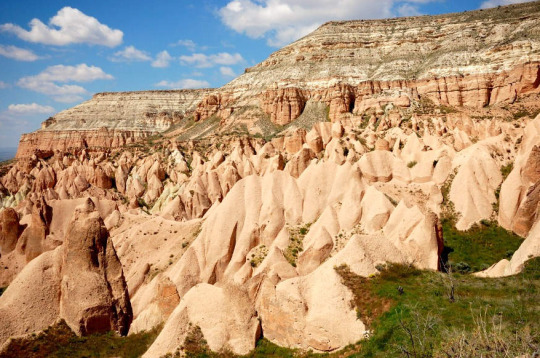
Pictured Above: The limestone formations of the Kipsian desert south east of Kipsu.
The Kipsian desert is the least populated region of Kishetal as the arid environment is not conducive to agriculture. Ruins of older civilizations suggest that the area may have once been more hospitable.
Plant life is sparse and largely limited to hardy shrubs and grasses. The region is famous for its carob and the candies and sweets produced from the carob by its inhabitants. Mesa, plateaus, pillars, and other stone structures are common; foreign visitors often visit the region seeking religious or spiritual enlightenment amongst the arches and columns. Many never leave.
Fauna include jackals, gazelles, kishic lions, deer, gazelle, wild asses, and hyenas. The Kipsian desert is also the only region in Kishetal in which the kishic ostrich and oryx survive.
Monstrous fauna include Flesh-eating deer, takmek, sikara, kiriki, and giant lions.
There are no forestfolk populations here.
7. The Macurian Steppe
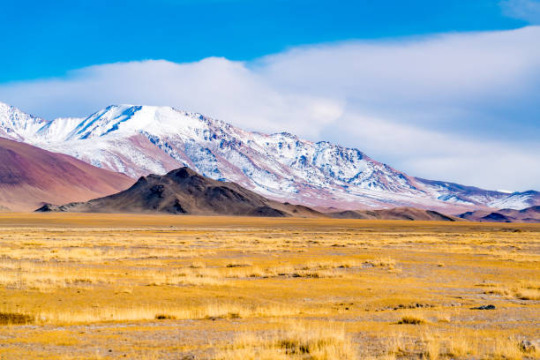
Pictured Above: The Macurian Steppe north of Shebal
The Macurian steppe is massive, spreading over most of western Macia. Only a tiny sliver of that vast extent falls in Kishetal. Trees are almost entirely absent. Vast expanses of grass-covered hills define the area. To the north of the steppe is the Shabalic forest, and to the south is the Jezaaic desert.
The heavy presence of sagebrush, sedges, and grasses and the relatively dry climate have led to a preference for a nomadic and pastoralist lifestyle. Macurian tribes regularly raid and intrude in the region, with their westward pushes typically being halted by the mountains.
Fauna include wild horses, wild asses, wild bulls, jackals, gazelle, deer, mountain sheep, macuri lions, and leopards.
Monstrous fauna include the tomob and the wulut.
There are only 3 native forestfolk populations in this region.
#worldbuilding#world building#fantasy#queer fantasy#fantasy world#fantasy writing#Kobani Narul Kishetal#Kobaniquestions#kobani#TestamentsoftheGreenSea
9 notes
·
View notes
Text
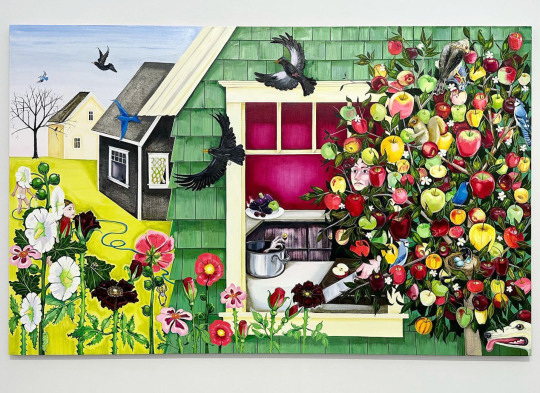


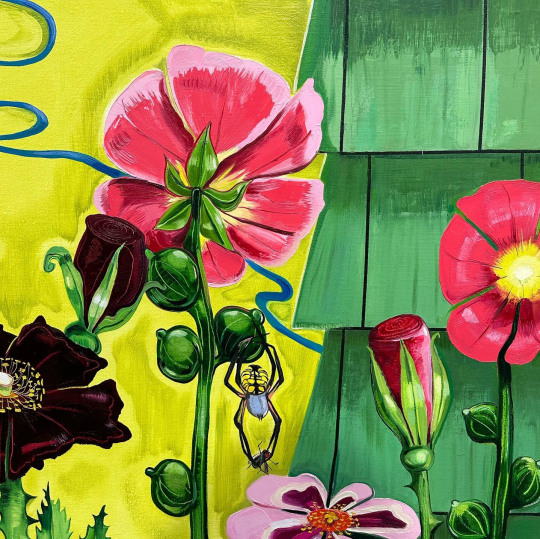


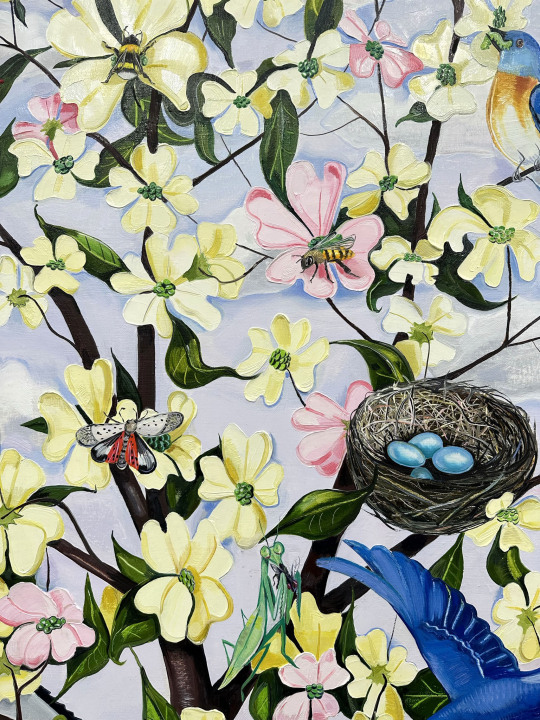
There’s more to Nikki Maloof’s paintings than meets the eye in her exhibition Skunk Hour at Perrotin. The more you look, the more details- often dark- begin to emerge.
From the press release-
For Nikki Maloof, painting is a way to convey the experience of existing in the world—the light, the dark, and all the shadows in between. Her language is figuration: she started out with portraits of individual animals, progressing onto still lifes and, most recently, domestic interiors and landscapes populated with a mix of creatures—human and non-human; alive, dead, and inanimate. These subjects, on one level, have an everyday familiarity. Indeed, they are in many instances collected from Maloof’s immediate environment: for the past few years, her house and studio in rural Massachusetts. But the resulting depictions, however vivid, never feel quite real. The colors are bright, the shapes cartoonish, the compositions often implausible. Everything is emotionally charged. The eyes of dead fish seem to brim with sadness, the oversized blade of a knife glints with menace. A woman who shares Maloof’s physical features stands at a window with a glum expression, her face only just visible behind a tree dense with apples. Looking at these canvases is like looking at a series of dreams, governed by a mysterious logic, their characters and events freighted with ambiguous symbolism.
Of course, unlike in a dream, Maloof chooses what to paint: hers is a conscious artistry. We see evidence of this in her equally accomplished graphite works on paper, in which images are carefully worked out before she embarks on the larger oils on linen. (It’s fun to play spot the difference between the versions in pencil and paint: notice how a glass of wine materializes on a countertop; how a cat relocates from the landing to the stairs.) Perhaps her work is more akin to confessional poetry, intensely personal yet meticulously crafted. The title of this exhibition, “Skunk Hour,” is borrowed from a well-known poem by Robert Lowell, published in 1959, which begins as a light-hearted description of a seaside town in Maine and culminates in a self-portrait of a mind in turmoil. “I myself am hell,” wrote Lowell, “nobody’s here— / only skunks, that search / in the moonlight for a bite to eat.” Similarly, Maloof describes the scenes she constructs as “vessels,” giving tangible form to psychological states or particular thoughts and feelings.
The idea for this new series of paintings hatched last spring, when one morning the artist stumbled upon the birth of a fawn near her home, and later that day witnessed the body of a recently deceased neighbor being removed from his home. She decided that she wanted to capture the weight of being made simultaneously aware of the beginning and the end of life, as well as the tension between the mundane and extraordinary. There are no laboring deer or body bags here: instead, we get paintings like Life Cycles (2022), in which five plates are arranged in a circle, showing the progression of fishes’ lives from small orange roe on crackers to clean-picked bones. Or Burning Bush (2022), in which an empty bird’s nest rests inches away from a hawk dismembering its prey on a branch of the same tree. Whether taking the form of conventional still lifes or more expansive house-and-garden scenes, Maloof’s coded pictures make clear reference to the conventions of Western religious vanitas painting, with its representations of physical objects—flowers, food, skulls—to symbolize the transience of earthly pleasures.
If this sounds unremittingly heavy, it’s not. Maloof’s paintings also offer up many of their own pleasures, both intellectual and sensuous. It would be remiss, for instance, to ignore the slapstick wit in the detail of a rolled joint on a kitchen shelf in the work entitled Skunk Hour (2022): skunk here signifying not the foul-odored mammal but the just-as-pungent strain of cannabis. Life, as Maloof understands, is nearly always funny, even when things are pretty bad. And if you’re not in the mood to laugh, well, just try to resist the delights of the paintings themselves—their profusions of color, pattern, and texture. Extending the culinary theme, we might describe her work as a feast for the eyes. See how the coiling smoke from the lit joint rhymes with the squiggles of steam rising above a pair of artichokes in a colander; notice the thick scraped impasto of the howling cat’s bristling fur. Maloof is unabashedly maximalist in her approach to her canvases, layering both imagery and brushstrokes, at times threatening to overwhelm her subjects through an abundance of painterly gesture. This makes perfect sense. In such moments it becomes clear that, despite the universality of their themes, Maloof’s paintings are a vision of the world as seen through the eyes of a singular artist.
This exhibition will close 4/15/23.
1 note
·
View note